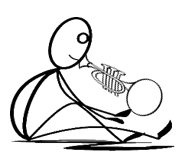Midwest Clinic Resources
Welcome Teachers and Students
You can find the many topics Greg discussed at his Midwest Clinic presentation right here. Enjoy!
Now you are ready to discover what TRUMPET MYTHS are to be avoided:
- Australians have kangaroos as pets!
- Brass instruments are hard to play
- You MUST buzz the lips (blow a raspberry)
- You MUST buzz the mouthpiece
- The lips close every vibration
- Changing mouthpieces is cheating
- You MUST blow the trumpet
- Breath using the diaphragm
- Articulate with the tip of the tongue behind the top teeth
- Blow faster to play higher
- Don't move the lips or arch the tongue

Greg Spence presented his Dispelling Brass Playing Myths session on day one of the 2016 Midwest Clinic.
The mistake most players make is to think that the lips make a sound in the mouthpiece and the trumpet amplifies the sound of the mouthpiece buzz. That is not what is happening and this approach makes playing difficult and does not sound very good.
The body and the instrument combine to make an air column and when air leaves the body after a good breath, the pressure of the air in the instrument changes. The lips start to vibrate thanks to the air pressure wave moving between the instrument and the body.
In the famous words of Rafael Mendez, "the trumpet is a wind instrument and you need plenty of wind to play it, not that one forces the air, never that; you never use more effort to produce the tone than what you do in normal conversation".
Imagine the instrument is playing YOU and you want it playing in to a relaxed concert hall, not a tight little practise room!

Imagine your body is a big concert hall and your instrument is PLAYING YOU. You are providing the energy and the body and instrument work together as one system.
Get Off to the Right Start
Some simple and easy ideas will help you get ahead of the rest.

To get started, watch the beginner videos to make sure you are on the right track.
Go to Beginner Series Videos
If you really love playing and want to get serious about it, remember these simple points:
- Backswing - Take a deep breath to open up the sound in the body; have you watched the 5 beginner videos? Give your instrument a concert hall to play in to, not a squeezed throat and tight chest; that is hard to do and doesn't sound very good!
- Release the air without kicking using the abdominal muscles; (some people call them the stomach muscles or the tummy muscles or the diaphragm which is very confusing).
- DO NOT squeeze your lips together trying to get them to BUZZ. This is not how the instrument works. Get the air to move gently between the lips and allow them to loosely vibrate. If you have a choking feeling, you are working too hard and fighting the instrument. All you need to do is get the air in the instrument to vibrate.
- You do not need to change the flow of air to change pitch to higher notes. The SHAPE of the mouth changes pitch and the flow of the air from the body determines VOLUME. If you ever get told to BLOW HARDER/FASTER TO PLAY HIGHER, get whoever says it to contact us so we can set them straight!

You don NOT need to feel like you are exploding when playing brass instruments. You do not need to force the lips together to make a sound. Keep the movement of air relaxed and free, and focus on a rich sound.
The BLUZZ
BLOW and BUZZ, two words that will send you backwards, FAST!
Watch, listen and learn. This video will change the way you play and teach.
Mouthpiece buzzing can be destructive; it can also be useful if done correctly with the right understanding.
THAT BEING SAID... Greg often does some lips buzzing and mouthpiece buzzing...HUH?
Lips Buzzing: A great way to get a vibration and blood circulating in the lips; but he knows that is not how to play the trumpet, it is a separate exercise.
Be sure the lips are loose and there is no choking or Valsalva Maneuver.
Mouthpiece Buzzing: There are several benefits to be gained from doing some mouthpiece buzzing, IF IT IS DONE CORRECTLY.
Some students that can't get the easy (sympathetic) vibration (oscillation) in the middle of the lips when playing the bubble tea (boba) straw or the leadpipe, can get the feeling required by using the mouthpiece alone.
DANGER lies in clamping down the lips and forcing of the airflow. This can create some devastating issues that has destroyed careers.
Understand that buzzing of the mouthpiece is NOT how the instrument works (if you want to sound good that is).
PLEASE NOTE: The instrument only becomes an amplifier of the mouthpiece buzz around a high Eb Concert. Some teachers and pro players may be confused about this line. There are many studies around explaining the reflection of the energy wave ceasing in the upper register. The diameter of the bell and the length of the sound wave are the determining factors.
Mouthpiece playing can be wonderful (when done correctly) for phrasing and interval training.
Mouthpieces
Changing Mouthpieces is CHEATING! Really?
Don't be fooled guys, mouthpieces change sound but do not give you extra range. Shallow mouthpieces may make the range that you already have easier to play, but you still need to develop an understanding of how to use different sized mouthpieces for the varied playing environments you may encounter.
The sound of a principle trumpet in an orchestra is entirely different to that of a lead big band trumpeter.
Learn how to approach different mouthpiece sizes


